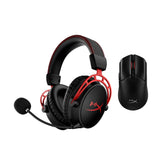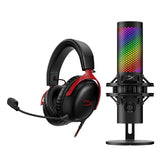A Beginner's Guide To Content Creation
If you want to kick off a career – or even a hobby – as a content creator, you’ve got some decisions to make. For example, what kind of content are you looking to create? Are you a prospective podcaster or a speculative streamer of games? In either case, you’ll need commitment, structure, and vision. You’ll also need the right content creation gear. The mindset side of the equation is up to you, but our beginner’s guide to content creation will cover everything else you’ll need to get started.
What will you create?
The first decision you’ll need to make as a beginner content creator may be the hardest: What kind of content are you going to make? The world of content is dauntingly vast, but here are are the broad categories most people fall into:
Video
Video content creation covers everything from video game Let’s Plays to multi-hour longform video essays. That’s a wide remit, but for a solo creator, the tools overlap. In addition to the gear we cover down below, you’re also going to need some form of video editing software. Adobe Premiere Pro is by far the most common paid application, but it comes with an expensive monthly cost. For someone dipping their toes in, free software like DaVinci Resolve will give you more than enough functionality to get started.
Top tip: There are a wealth of free guides available on YouTube which will show you how to create those nice video transitions and effects you’ve seen in movies or online. When you see something like a whip pan or title overlay that you’d like to give a go, try searching for a YouTube tutorial! And if you’re struggling to find the right search term, check out a glossary of filmmaking terms to describe what you want.
Streaming
Whether you’re planning to broadcast games, showcase live arts and crafts, or just want to keep conversation going with your chat, becoming a streamer necessitates dedication, consistency, and planning. On top of that, you’ll also need some streaming software. The most common choice for beginners is Open Broadcast Software Studio, or OBS for short. This free program will let you capture anything on your computer and broadcast it to platforms like Twitch, YouTube, and Facebook with relative ease.
Top tip: When starting, pick a regular streaming cycle you know you’ll be able to stick with – don’t be tempted to go overboard from the beginning. A consistent schedule will mean viewers know when and where to find you again if they enjoy your show.
Podcasting/Voice Overs
Podcasting, voice over, and voice acting all share the same primary concern: audio. Whether you’re planning to partner your voice with video or not, your voice is the star here, and you’ll need gear and software capable of cleanly capturing your voice and editing out any script stumbles. We’ll get to the equipment later, but on the software end, most beginners start with Audacity or Reaper. Audacity is free and contains plenty of editing options, while Reaper is more fully-featured, but only with a 60-day free trial.
Top tip: If you can’t afford a fancy sound-proofed booth, find a small space in your home like a cupboard or wardrobe. Confined spaces – especially if they’re packed with soft items like clothes – will drastically reduce any echoes in your recordings, making them far more palatable for your future listeners.
Content creation platforms
Next on your agenda is deciding where you want to host your creations. We’ve covered the most common options below. Whichever platform you choose, it’s worth creating a dedicated account for your show or channel, which will give you separation from any you use privately. Gotta keep that work-life balance in check!
YouTube (Video/Streaming/Podcasts)
Catering for almost every kind of content out there, YouTube is a crowded marketplace. But it’s also one of the easiest places to get started. It features an excellent set of free creator tools to track your results. Even podcasters should consider uploading a version to a YouTube channel if they have time. Meeting people where they are is a great rule of thumb to abide by. If you want to put in the extra work, pair the recording with camera footage from the room or visuals that help convey the information you’re delivering.
Twitch (Streaming)
Twitch is a dedicated streaming platform made for live broadcasts. Create an account and link it up with OBS, and you’ll be able to start streaming from your PC in no time at all. It’s got plenty of tools available to help you manage your chat, and there are partnering options to consider when things pick up.
TikTok/YT Shorts/Instagram (Video/Streaming)
Want the quickest path possible into content creation? Mobile-focused platforms like TikTok and YouTube Shorts allow you to get started with nothing more than your phone camera. They’re a great choice for short-form, in-person content if you don’t want to mess about with expensive gear or recording game footage. Just make sure you’ve got a decent phone camera and can record in a quiet place without distractions.
While Instagram is largely targeted toward photographers with some image editing skills, it – along with TikTok and YT Shorts – can also play host to more complex, edited videos. Just be aware that you’ll need to export anything you make in the correct orientation and format for your platform of choice.
Apple Podcasts / Google Podcasts / Spotify
Podcasters are spoiled for choice when it comes to hosting platforms, but Apple, Google, and Spotify have the biggest audiences by far. The good news? You don’t actually need to pick between them. There’s no downside to uploading your podcast on all three platforms, provided you don’t mind putting in the time to promote it on each one, too. And there are distribution tools to help you manage all platforms simultaneously, like Podbean and Buzzsprout. Include a generalized call for ratings and reviews somewhere during the podcast and you’ll cover all your bases.
Content creation gear
Here’s the unfortunate truth: content creation can be an expensive hobby or career to start in. Depending on the content you want to make and the platform you’ll be making it for, you’re going to need a selection of equipment that can rack up a hefty price tag. But there’s no need to panic just yet!
Dropping hundreds to thousands of dollars on a fancy single lens reflex camera might secure you the sharpest images at the highest resolution, but it’s far and above what most beginner content creators require. Below, we’ve picked out some key pieces of content creation gear you’ll want depending on what you’re looking to make. We’ve selected products that’ll deliver serious quality without compromising the long-term health of your bank balance.
Microphone: HyperX QuadCast S
Ideal for:
- Video
- Streaming
- Podcasts
- Voice Over
- Gaming
If you’re planning to put those vocal cords to use in any manner as a content creator, an excellent microphone is a must. The HyperX QuadCast S USB microphone is a superb choice that’ll deliver no matter what kind of content creation you’re aiming for. It comes with a built-in anti-vibration shock mount, an internal pop filter, and manual gain control. Adjustable RGB lighting patterns mean you can match the mic to your studio aesthetic, and the four selectable polar patterns allow you to easily get your mic setup for face-to-face or full-room recordings.
Dedicated voice over artists, voice actors, and solo podcasters may want to consider aiming for the HyperX ProCast instead. It’s a professional-grade XLR condenser microphone designed for solo recordings, so you’ll need an audio mixer to interface with the PC. Snap on the HyperX Shield pop filter, and your dulcet tones will never have sounded more appealing. Looking to fine-tune that budget or don’t have an XLR mixer yet? The HyperX SoloCast is a brilliant entry-grade USB microphone built to deliver hi-res audio with a minimal-fuss, plug-and-play connection.

Webcam: HyperX Vision S
Ideal for:
- Video
- Streaming
Appearing on-screen in videos or while streaming can help you connect with your viewers, but not if your webcam has you looking like a blurry, stuttery mess. Thanks to its 8-megapixel 4K Sony Starvis sensor, the HyperX Vision S will ensure your actions are captured smoothly and clearly – even when showing off a newly mastered K-Pop dance move to celebrate a game win.
The Vision S features a wide 90° field of view in case you want to flaunt your curated studio setup, but the built-in auto-focus will ensure you’re kept center stage at all times. Any content creator should be well-aware that privacy is of paramount concern. The Vision S includes a magnetic cover to physically block the webcam’s view when recording is finished, and the LED indicator will alert you whenever it’s in use, so you’ll never accidentally go live while eating at your desk again.

Monitor: HyperX Armada 25 QHD
Ideal For:
- Video
- Streaming
- Gaming
When it comes to content creation, multiple screens are all but a necessity. That extra virtual space grants the utility to manage background software or your stream chat, especially when the main screen is taken up by gaming or other full-screen applications. The difficulty comes in finding physical room for all those screens. HyperX’s Armada line of monitors are available as a set with a desk mount and monitor arm included, which will keep your surface clear of space-hogging desk stands.
That physical utility pairs with premium visuals, too. The Armada 27 features a QHD (2560x1440) IPS panel with a 1ms response time and an impressive 165Hz refresh rate – that’ll ensure any games you play look just as slick as you do while streaming.
Sound controls: HyperX Audio Mixer
Ideal for:
- Streaming
- Podcasting
- Voice Over
Streamers need to handle a lot of inputs on the fly, and managing them on-screen can be a major hassle. The HyperX Audio Mixer aims to ease that burden. It can handle inputs from up to three audio sources – an XLR microphone input, a 3.5mm microphone input, and a stereo 3.5mm input – at once, with individual faders and mute buttons for each. That makes it a breeze to balance your mic, voice chat, and game audio without disrupting your show. And for podcasters or voice over artists planning on picking up the ProCast, the Audio Mixer supports 24-bit/96kHz recordings to guarantee you’re capturing professional-grade sound.
For consoles: Capture card
Ideal for:
- Video
- Streaming
If you’re planning to edit or stream console gameplay, you’ll likely need a capture card to get that footage onto your PC. Elgato and AVerMedia are the two major suppliers in the market, and both offer compact packages for a selection of budgets. Aim for 1080p/60fps support as a minimum to keep your footage crisp for viewers.
That should cover all the key gear and choices you’ll want sorted as a beginner content creator. If you’re planning to stream video games, make sure you bring out the best in your games and equipment by powering everything with a dedicated gaming PC like the Omen 40L.





